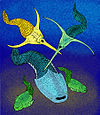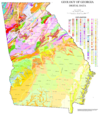User:Abyssal/Portal:Silurian
IntroductionSelected article on the Silurian world and its legacies
The subphylum (or phylum) Chelicerata constitutes one of the major subdivisions of the phylum (or superphylum) Arthropoda, and includes horseshoe crabs, scorpions, spiders, mites, harvestmen, ticks, and Solifugae. Like all arthropods, chelicerates have segmented bodies with jointed limbs, all covered in a cuticle made of chitin and proteins. The chelicerate bauplan consists of two tagmata, the cephalothorax and the abdomen. The group is named for their chelicerae, appendages near the mouth generally used to feed. The group has the open circulatory system typical of arthropods, in which a tube-like heart pumps blood through the hemocoel, which is the major body cavity.
Chelicerates were originally predators, but the group has diversified to use all the major feeding strategies. The guts of most modern chelicerates are too narrow for solid food, and they generally liquidize their food by grinding it with their chelicerae and pedipalps and flooding it with digestive enzymes. Most lay eggs that hatch as what look like miniature adults. In most chelicerate species the young have to fend for themselves, but in scorpions and some species of spider the females protect and feed their young. The chelicerata originated as marine animals, possibly in the Cambrian period, but the first confirmed chelicerate fossils, eurypterids, date from 445 million years ago in the Late Ordovician period. The surviving marine species include the four species of xiphosurans (horseshoe crabs), and possibly the 1,300 species of pycnogonids (sea spiders), if the latter are chelicerates. (see more...) Selected article on the Silurian in human science, culture and economics
The geologic map of Georgia (a state within the United States) is a special-purpose map made to show geological features. Rock units or geologic strata are shown by colors or symbols to indicate where they are exposed at the surface. Structural features such as faults and shear zones are also shown. Since the first national geological map, in 1809, there have been numerous maps which included the geology of Georgia. The first Georgia specific geologic map was created in 1825. The most recent state-produced geologic map of Georgia, by the Georgia Department of Natural Resources is 1:500,000 scale, and was created in 1976 by the department's Georgia Geological Survey. It was generated from a base map produced by the United States Geological Survey. The state geologist and Director of the Geological Survey of Georgia was Sam M. Pickering, Jr. Since 1976, several geological maps of Georgia, featuring the state's five distinct geologic regions, have been produced by the federal government. (see more...)
Selected image
Did you know?
Need help?Do you have a question about Abyssal/Portal:Silurian that you can't find the answer to? Consider asking it at the Wikipedia reference desk. GeochronologyEpochs - Llandovery - Wenlock - Ludlow - Pridoli Plants - Lycopods - Rhyniophytes - Vascular plants Fossil sites - Yea Flora Fossil Site Researchers - Increase A. Lapham - Roderick Murchison Quality ContentFeatured Silurian articles - Fungus SubcategoriesRelated contentAssociated WikimediaThe following Wikimedia Foundation sister projects provide more on this subject:
|






















